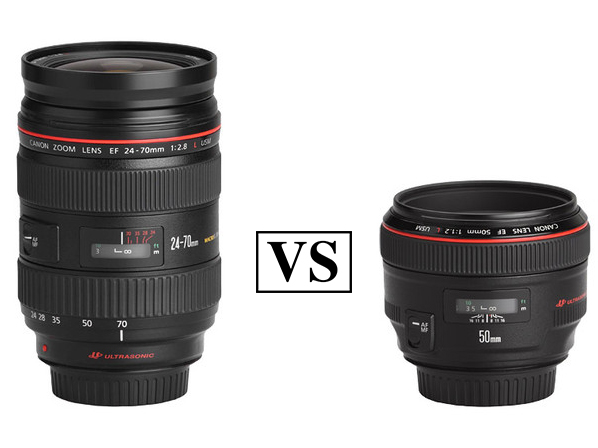There are two primary types of lenses in the photography world and both have their unique advantages. Prime lenses are almost always optically superior to their zoom counterparts but can at times be less versatile. Many photographers prefer one over the other although most have a variety of both. Keep in mind that whenever comparing different types of lenses we are using broad generalizations - every specific lens differs slightly. With that said, let's find out which type is right for you and most importantly why.
Primes
Prime lenses have a fixed focal length and do not zoom. If you want to frame your subject differently you need to physically move either closer or further from your subject. Since prime lenses are designed for a specific focal length rather than a broad range their construction is generally much simpler than that of zoom lenses. Although zoom lenses have some advantages of their own, even entry level prime lenses compete with or even outperform professional zoom lenses in most cases. The simple optical design in prime lenses allow for a variety of advantages over zooms:
Smaller
Lighter
Sharper, Even Wide Open (especially in the corners)
More Affordable
Better in Low Light (large aperture lets in more light)
More Depth of Field (large aperture blurs backgrounds)
Simple prime lens designs are cheaper to manufacture and therefore generally result in more affordable options when compared to zoom lenses. Prime lenses also outperform zoom lenses since their lens structure is less prone to optical aberrations (or imperfections) that affect sharpness, vignetting, distortion, chromatic aberration, lens contrast and more. You can usually grab several outstanding primes for LESS than what you would pay for a single professional zoom, which I'll lay out for you in a minute.
Zooms
Zoom lenses cover a range of focal lengths within one lens. This is extremely beneficial to wedding and event photographers as you can use a single lens for quick adjustments rather than switching lenses. The primary benefit to a zoom is that they can be more versatile and/or convenient than their prime counterparts. Unfortunately, the good news ends here as this added flexibility comes at a cost. Decent zoom lenses are large, heavy, expensive, and more prone to optical flaws. Manufacturers are forced to make compromises for each focal length while trying to achieve the best performance overall. Here are a few benefits that zoom lenses hold:
More Versatile
Often Have Image Stabilization (though primes can too)
Common Filter Size (across range of focal lengths)
Less Lenses to Carry
While it is true that Image Stabilization (Vibration Reduction, Optical Steady Shot, etc) is more common on zoom lenses, it can also be found on primes which makes this only a partial advantage. Many primes can also be found with common filter sizes and although you carry less lenses when using zooms they weigh 4x as much. These are all things to keep in mind.
Although professional zooms have improved greatly over the years I still suggest you stick with primes whenever possible. With that said, I realize that in many situations the flexibility of zoom lenses are simply essential.
Which do I prefer? Why?
Let me start by mentioning that it takes a while to find the gear that works best for you. I have owned dozens of primes and zooms from Canon, Nikon, Sony, Sigma, Tamron, Samyang, Zeiss, Leica and more. Be patient and the more you shoot the more you'll start to see your style form.
If you haven't noticed yet, I have long been an advocate for prime lenses. Personally I've found primes to offer more value in a smaller and more affordable package. When you shoot primes you get to know certain focal lengths more intimately. For example, I know exactly what my 35mm will give me before I even put it up to my eye. Shooting primes have helped me think critically about the choice of lens that i'm using for a shot and have improved my photography substantially. When I was more focused on shooting weddings I shot with only primes for some time- typically 14mm f/2.8, 24mm f/2.8, 35mm f/1.4, 85mm f/1.8, 105mm f/2.8 Macro. Though it is a challenge it can be done and I quickly found that when shooting with two bodies you simply keep a wider option on one with a varying focal length on the other.
Now that's not to say that there are not exceptions, cause there certainly are. I would say that most wedding photographers prefer to have zoom lenses as they offer a peace of mind knowing that you can instantly reframe at different focal lengths during a fast paced day. Many sports and action photographers make the necessary compromise that comes with zoom lenses so that they can ensure more accurate framing with unpredictable athletes.
Equipment is only useful in its ability to help us reach our creative vision and everyone's needs are different. The most important thing is that you carefully analyze your style of shooting and build a kit that best supports you.
Below are some real world comparisons of some coveted zoom lenses and potential prime lens substitutes. Due to the vast difference in price I have been generous in listing several primes to illustrate the gained value you can receive for EVEN LESS MONEY. With that said, please note that I've never needed 4 primes to replace a zoom lens' range. You really do not need every single focal length covered and typically 2 or 3 primes will be more than enough to move freely and frame creatively. With a high megapixel camera you also have some flexibility to crop and I'll usually walk around with a 28mm and 50mm for example
Above is an excellent example comparison for primes vs zooms. When choosing the primes you not only gain the faster aperture on the 35mm and 50mm but also true macro capability from the 60mm. The Nikkor 24-70 f/2.8 simply cannot give you the same background blur, or bokeh, as the faster primes and certainly doesn't shoot macro. Let me put it this way- An entry level DSLR with a 50mm f/1.8 ($700) can have the same DOF as a pro level DSLR with 24-70mm f/2.8 ($4000-5500). No, that's not the whole story, but it should hopefully make a point.
In the above comparison of Canon lenses you can see that by choosing the prime lenses you gain Image Stabilization on the 24mm and 35mm. In addition to the faster aperture of the 35mm, 50mm, and 85mm you also gain an expanded focal length with the 85mm. In terms of weight, the Canon 24-70 f/2.8 II weighs more than the 24mm, 35mm, and 50mm combined. Since you get that all for less money the only reason to buy the zoom is it's quick versatility and convenience.







